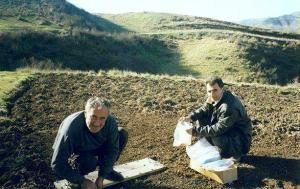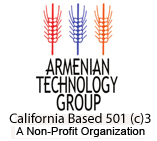Tavoush -- Tenacious Villagers Work Border Lands
| January 1, 2006
 For additional photos related to this article, visit the ATG Photo Gallery. Movses, Province of Tavoush, Armenia — High in the mountains, above the villages of Verin Karmraghbyur and Aygepar, a dirt road leading to Movses winds above several Azeri villages, close enough to see women tending their gardens, and dogs running behind horse-drawn carts. An imaginary border runs down a high mountain, separating the Azeri villages from the Armenian village of Movses. At the entrance of the village, a ruined tank stands as a reminder of the recent war. In a patio inside the large, two-story home of farmer Hrant Shoryan, several men and women were gathered. They talked about their ancestral village of Movses, and their struggles during the recent war and after the Soviet breakup. “We are directly on the border,” Mrs. Shoryan said. “For months, years, we were hit by cannon and tank fire. We had to bury our dead under the cover of nightfall. But, Azeris didn’t enter our village. Not once. Our people are brave people. We are hospitable, and love humor. We are hard-working. Above all, we love our traditions, our land.” As the woman spoke, her aging father, Mardiros, sat at a large, wooden table. In his youth, Mardiros was the “seedsman” of Movses, one who sowed wheat by hand, doing it so well that the fields grew as evenly as those sown with today’s modern planters. “Our young men have left the village,” Mrs. Shoryan explained. “Most of them are working in Russia — the same men who defended our village, just a few short years ago. They are our farmers, the fathers of our children. I worry about the future of Movses. In this remote region, anything can happen. We need to be strong.” Mrs. Shoryan continued: “This past year, I am happy to say, our new friends from Yerevan, Gagik Mkrtchyan and Vaghinak Kamrastyan came to Movses, and other villages in Shamshadin, and offered us wheat seed for our autumn planting. For us, this was like a miracle. The seed we were planting had become mixed, so much that we couldn’t even tell what variety we were harvesting. Our harvests were low. We barely had enough flour to bake bread. Our situation was terrible.” Mkrtchyan and Kamrastyan, agronomists from the Yerevan office of the Armenian Technology Group (ATG), and Zareh Misserlian, a member of the organization’s board of directors, listened attentively. “People, and organizations, come here to help us,” Mrs. Shoryan said. “We appreciate this. But no one is like these men. They come, and listen to our concerns. And the wheat seed they brought was excellent. We haven’t had harvests this good in 10 years. Everybody is satisfied, and wants more seed for the next sowing. We know the seed Gagik and Vaghinak bring will be good. You should have seen what others were offering.” From the Shoryan household, Mkrtchyan, Kamrastyan, and Misserlian drove their Niva jeep up a narrow village road to visit Santour Arakelyan, a farmer who had used his truck to bring nearly 10 metric tons of wheat seed to Movses for the autumn planting in 2004. Mkrtchyan, director of the ATG-created Seed Producers Support Association, told about the 2004 sowing in Movses: “Here, the fields are located high above the village,” he said. “Farmers had no way to bring the seed from Aygepar, where the seed had been delivered, up to their fields in Movses. The roads are bad, and dangerous at times, since they are right on the border with Azerbaijan. With his truck, Santour hauled enough seed for all of Movses’ farmers. He even had enough seed to take to villages more remote than Movses, such as Chinari and Chinchin. What he did for these villages is incredible.” Reaching the Arakelyan household, the men were greeted by Mrs. Arakelyan and two young grandchildren. “Santour is in the fields,” she said, offering homemade bread and wine to the visitors. “He is working with the newly harvested wheat. Our harvest was good. We are satisfied. I remember after WWII, when we walked to school barefoot. Then, in 1992-93, things got even worse in Movses. We appreciate what you and your organization have done, bringing us good wheat seed. Here, enjoy our bread. It is made from this year’s harvest.” Nachaka and Sergey Antonyan, known as heroes in Movses, arrived in the outdoor courtyard. “Welcome to our village,” Sergey said. “We want to thank you for all your help, in bringing seed to Movses. Thanks to you, and Santour, we were able to plant and harvest good, healthy wheat.” As they spoke, other farmers, hearing about the visitors from Yerevan, entered the courtyard. Antonyan continued: “This year,” he said, “we didn’t have enough money for herbicide, and had a weed problem. Next year, we will be able to afford to buy herbicide and fertilizer, and our harvest should be even better.” New sowing foretells bright future On a late-November afternoon, as an icy wind blew over the fields of Movses and Verin Karmraghbyur, Mkrtchyan, Kamrastyan, and several local farmers worked feverishly to sow several varieties of winter wheat on a small plot and on three 1,000-hectare plots. Gevorg Movsisyan, a farmer and electronics specialist from the regional center of Bert, helped Mkrtchyan load the planter. “We need to sow today,” Movsisyan said. “It looks like snow is on the way. If we don’t plant today, and snow falls, the ground will be too wet and muddy to plant.” On the top of a hill, a shepherd watched the men work. In the background, high forested mountains led to the distant village of Chinchin. To the north, Nerkin Karmraghbyur lay nestled in a small, treed valley. “On the large plots, we will plant for seed multiplication,” he said. “I have high hopes, especially for Stevens, which grows well here, and doesn’t develop rust. But the other varieties, such as Baldasar and Leninakan 5, look great too.” On a small, 24-square meter plot, Kamrastyan and Aygepar farmer Andranik Hovakimyan planted over 20 varieties of wheat and barley. “This experimental plot is in the perfect spot,” Kamrastyan said. “Farmers driving to Movses, Verin Karmraghbyur, and Chinchin pass this road. They will be able to see which varieties grow best, and decide for themselves which varieties best suit the climate and soil here in Shamshadin.” When it was nearly dark and the men were finishing their work, a light snow began to fall. Mkrtchyan looked up and smiled. “This makes it all worthwhile,” he said. For more information about how you can help Armenia’s farmers, contact the ATG office at (559) 224-1000 or by e-mail (info@atgusa.org). Tax-deductible donations can be sent to ATG; 1300 E. Shaw, Suite 149; P.O.Box 5969; Fresno, CA 93755-5969. |
|


Follow Us